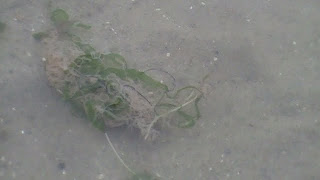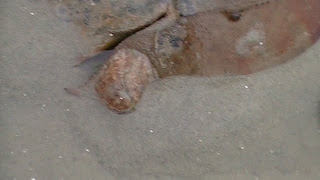Today, before setting off to Chek Jawa, we had a little surprise in store for us.
 We saw an oriental pied hornbill (Anthracoceros albirostris) perched on a papaya tree right beside the volunteer hub! Everyone was scrambling for their cameras as the majestic bird seemed to deliberately pose for shots.
We saw an oriental pied hornbill (Anthracoceros albirostris) perched on a papaya tree right beside the volunteer hub! Everyone was scrambling for their cameras as the majestic bird seemed to deliberately pose for shots.
 Eventually, the hornbill flew away. The way it flies is more like gliding, really. At Chek Jawa, I was chosen to be the hunter seeker, the person who looks for live specimens for the visitors. Coincidentally, the same thing happened today, like yesterday! Once again, 1 group paid a few hundred dollars for just 1 tour! Now everybody is suspecting that there's something wrong with the system.
Eventually, the hornbill flew away. The way it flies is more like gliding, really. At Chek Jawa, I was chosen to be the hunter seeker, the person who looks for live specimens for the visitors. Coincidentally, the same thing happened today, like yesterday! Once again, 1 group paid a few hundred dollars for just 1 tour! Now everybody is suspecting that there's something wrong with the system.
 While on the coastal boardwalk, we spotted a monitor lizard (Family Varanidae) walking along the mudflat. It seemed to notice us and started running, but slowed down eventually. After hunter-seeking at the seagrass areas and the mudflats, the hunterseekers took to the coral rubble area.
While on the coastal boardwalk, we spotted a monitor lizard (Family Varanidae) walking along the mudflat. It seemed to notice us and started running, but slowed down eventually. After hunter-seeking at the seagrass areas and the mudflats, the hunterseekers took to the coral rubble area.
 The seagrass pools near the coral rubble area were dotted with hundreds of baby anemones! Jackie mentioned that these were baby swimming anemones (Boloceroides mcmurrichi).
The seagrass pools near the coral rubble area were dotted with hundreds of baby anemones! Jackie mentioned that these were baby swimming anemones (Boloceroides mcmurrichi).
 While I hunted around the coral rubble area for more animals, I almost stepped upon this Denison's nudibranch (Dendrodoris denisoni)! If you look closely, you can see bright blue spots on its body.
While I hunted around the coral rubble area for more animals, I almost stepped upon this Denison's nudibranch (Dendrodoris denisoni)! If you look closely, you can see bright blue spots on its body.
 There were plenty of these mermaid's fan seaweeds (Padina sp.) too.
There were plenty of these mermaid's fan seaweeds (Padina sp.) too.
 I managed to see yet another thunder or stone crab (Myomennipe hardwikki). Ali had already caught one earlier on, and just a show of strength and aggression, the thunder crab he tried to catch actually pinched and even bent part of the plastic container! He had to spend quite some time getting it into the plastic container.
I managed to see yet another thunder or stone crab (Myomennipe hardwikki). Ali had already caught one earlier on, and just a show of strength and aggression, the thunder crab he tried to catch actually pinched and even bent part of the plastic container! He had to spend quite some time getting it into the plastic container.
 On one of these rocks was a thumbs up sea squirt (Polycarpa sp.), and something else right beside it...
On one of these rocks was a thumbs up sea squirt (Polycarpa sp.), and something else right beside it...
 was another type of colonial ascidian, the melted chocolate ascidian (Ascidiacea). This type has strange brown patterns all over it.
was another type of colonial ascidian, the melted chocolate ascidian (Ascidiacea). This type has strange brown patterns all over it.
 Te coral rubble area has the richest variety of sponges, like this sponge, which is probably an elegant branching sponge (Haliclona sp.)
Te coral rubble area has the richest variety of sponges, like this sponge, which is probably an elegant branching sponge (Haliclona sp.)
 Then, Jackie called to me and said that he found a stingray. This is a blue spotted fantail ray (Taeniura lymma). I had never seen one alive before, only one dead stingray. We must be very careful when around this stingray, for it gives a really bad sting if stepped on.
Then, Jackie called to me and said that he found a stingray. This is a blue spotted fantail ray (Taeniura lymma). I had never seen one alive before, only one dead stingray. We must be very careful when around this stingray, for it gives a really bad sting if stepped on.
 A close-up shot of this stingray gives a clearer view of its bright blue spots, as well as its gills.
A close-up shot of this stingray gives a clearer view of its bright blue spots, as well as its gills.
 There were plenty of thorny sea cucumbers (Colochirus quadrangularis) at the coral rubble area, too.
There were plenty of thorny sea cucumbers (Colochirus quadrangularis) at the coral rubble area, too.
 There were several Haddon's carpet anemones (Stichodactyla haddoni) to be seen, too, and these were truly bigger than your face!
There were several Haddon's carpet anemones (Stichodactyla haddoni) to be seen, too, and these were truly bigger than your face!


 And here are even more sponges, in different colours, too!
And here are even more sponges, in different colours, too!
 I found some unidentified eggs here. Perhaps they're some form of sea slug eggs.
I found some unidentified eggs here. Perhaps they're some form of sea slug eggs.
 I also spotted a peacock anemone (Order Ceriantharia) below the floating pontoon.
I also spotted a peacock anemone (Order Ceriantharia) below the floating pontoon.
 If you look closely at the sand, you'll be able to see a common sea star (Archaster typicus) underneath.
If you look closely at the sand, you'll be able to see a common sea star (Archaster typicus) underneath.
 Another bunch of unknown egg masses. This time I suspect nudibranchs.
Another bunch of unknown egg masses. This time I suspect nudibranchs.
 This rather large snail is a noble volute (Cymbiola nobilis). It is an active predator, using its large mantle to suffocate smaller snails.
This rather large snail is a noble volute (Cymbiola nobilis). It is an active predator, using its large mantle to suffocate smaller snails.
 The underside of the noble volute reveals its pretty mantle.
The underside of the noble volute reveals its pretty mantle.

 These two small secretive crabs are the reticulated moon crab (Matuta planipes) and the elbow crab (Family Parthenopidae). The reticulated moon crab is really pretty, I've never seen this species of moon crab before!
These two small secretive crabs are the reticulated moon crab (Matuta planipes) and the elbow crab (Family Parthenopidae). The reticulated moon crab is really pretty, I've never seen this species of moon crab before!
 Contrary to the enormous carpet anemone seen just now, this one is much smaller, due to the low tide.
Contrary to the enormous carpet anemone seen just now, this one is much smaller, due to the low tide.
 Here are more bristleworms (Class Polychaeta), except these are black! Hmmm...I've never seen black bristle worms before.
Here are more bristleworms (Class Polychaeta), except these are black! Hmmm...I've never seen black bristle worms before.
 Can you see what is in the pool above? It is a longspined scorpionfish (Paracentropogon longispinis). It is quite small, and quite active, too!
Can you see what is in the pool above? It is a longspined scorpionfish (Paracentropogon longispinis). It is quite small, and quite active, too!
 There was also this rather large garlic bread sea cucumber (Holothuria scaba), commonly known as sandfish in trade.
There was also this rather large garlic bread sea cucumber (Holothuria scaba), commonly known as sandfish in trade.

 These are two more echinoderms, the plain sand star (Astropecten sp.) and I think this is a see-through sea cucumber (Paracaudina australis). The strange part was, the see-through sea cucumber was floating when I put it in the water! weird...
These are two more echinoderms, the plain sand star (Astropecten sp.) and I think this is a see-through sea cucumber (Paracaudina australis). The strange part was, the see-through sea cucumber was floating when I put it in the water! weird...
 This rather strangely coloured soft coral is probably a dying pink flowery soft coral (Family Nephtheidae).
This rather strangely coloured soft coral is probably a dying pink flowery soft coral (Family Nephtheidae).
 I also spotted this ball sea cucumber (Phyllophorus sp.) out of the corner of my eye.
I also spotted this ball sea cucumber (Phyllophorus sp.) out of the corner of my eye.
 I even found this coastal horseshoe crab (Tachypleus gigas) at the coral rubble area.
I even found this coastal horseshoe crab (Tachypleus gigas) at the coral rubble area.
 A closer look reveals a little blob by its side, which is really an anemone!
A closer look reveals a little blob by its side, which is really an anemone!
 The best find of the day must be this adult tongue sole. Wow! Thankfully, a bird of prey didn't come and sweep it right off the ground!
The best find of the day must be this adult tongue sole. Wow! Thankfully, a bird of prey didn't come and sweep it right off the ground!
 This is the adult version of the smaller swimming anemones I saw previously.
This is the adult version of the smaller swimming anemones I saw previously.
 And finally, a couple of biscuit sea stars (Goniodiscaster scaber). These can be found at the coral rubble area too.
And finally, a couple of biscuit sea stars (Goniodiscaster scaber). These can be found at the coral rubble area too.
 This strange jelly-like blob is probably a dead huge jellyfish. Well, that's all for today. I had a really good time exploring the coral rubble area today!
This strange jelly-like blob is probably a dead huge jellyfish. Well, that's all for today. I had a really good time exploring the coral rubble area today!










































1 comments:
What a lovely blog about one of my favourite shores. Bravo! And looking forward to more posts. All the best for a great year ahead. Ria.
Post a Comment